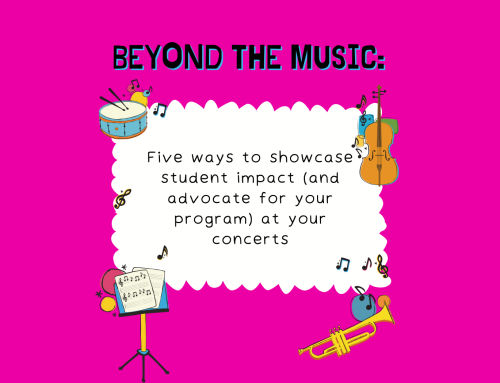The bell rings.
I see a group of adolescents walking into my room. Under my mask, I’m smiling. But, inside, I’m anxious.
I just received an email from a parent who’s upset about a situation that occurred in class the day before; I’m questioning the way I handled a student last period. I forgot to copy the music we are supposed to be reading today. Between war, the pandemic, and social unrest, I don’t know if my students are ok. I worry about my own kids at school and whether or not I remembered to pack a lunch this morning.
How could I NOT be anxious?
My students take their seats with their invisible backpacks of worry and stress. They’ve just read a social media post or a text that upsets them. They are worried about global crises and whether their communities will be ok. They are stressing about tests that have happened or will happen later that day. They wonder how they will be able to balance all of their responsibilities.
How could they NOT be anxious?
As the students take their seats, I point to the affirmation of the week on the board (This week’s affirmation is “I can be present.”) and invite students to practice our breathing activity together. The mood in the room shifts, students become quiet, and we close our eyes. I count quietly as we breathe in…..hold…..breathe out……hold….repeat.
I wonder, “when did my job as a music teacher shift to include so much emotional regulation?”
Table of Contents
The reality of teaching
I know that many teachers are anxious, stressed, burned out, and feel like there is no end in sight. I know this because our most-read blog post on this site is one about leaving the profession. I know this because of the masses of teachers leaving the profession (for a host of valid reasons!). I know this because of the social media posts I see every day. I know this because I am a teacher right now.
So, how do we continue on a path in education and support ourselves and our students? First, I need to be clear that I am not a medical professional and don’t know the ins and outs of everyone’s individual situation. I don’t think there is a quick fix for any of our educational system’s pervasive problems.
I do, however, know that there are ways that we can use the power of the present to center wholeness for both ourselves and students.
Anxiety and our response
What is anxiety, anyway?
I was listening to an episode of the Happiness Lab recently, and the host, Dr. Laurie Santos, talked to psychotherapist Andrea Wachter about this very issue. Andrea explained something that I have been carrying with me ever since. I am paraphrasing her words here:
If you have anxiety, you are most likely not in immediate danger. If you were in immediate danger, you would respond and react to the threat. Anxiety is the worry over the “what ifs” and a response to “what was.” It is not necessarily an accurate picture of “what will be.”
When we experience anxiety, our mind plays stories and scenarios that have been or might be. I wish someone had shared this with me when I was a teenager and had given me the tools to come back to the present.
So, what can we do when we’re feeling anxious? How can we address the genuine feelings in our bodies and the sensations that make us anxious or come as a result of our anxious thoughts?
In the podcast episode above, Andrea encourages us to that,
- Breathing Calms our System
- Moving Our Bodies Calms our System
How might breathing and moving be incorporated into your classroom as a therapeutic practice (not just for you but also for your students)? As music teachers, many of us naturally integrate movement into our lessons. But, is there a way to identify what we collectively need in a given moment?
What to do when our body reacts
Sweaty palms. A pit in the stomach. Blurred Vision. Shaking legs.
How does anxiety affect you physically? What about your students? Can they identify when their body responds to something that is making them anxious?
Andrea encourages us to try a few different things in the midst of anxiety.
- Observe (without judgment!)
We can acknowledge what our body is experiencing without judgment. So many of us have negative feelings about our negative feelings! How can we recognize what we’re feeling with a sense of compassion?
- Self-Haven
Andrea describes a technique of using sensory touch and calming words or images to self-soothe. This might sound crazy, but you should try it! Rub your hands together to generate some heat and lightly touch the upper arms and the sides of your face. Try it with your kids while listening to calming music.
- Mindfulness
Come to the present moment. What is actually factually here? It’s ok if you’re still feeling anxious while you’re “coming to your senses.” It’s not a quick fix, but a way to start moving from the stories in your head to the present reality of what is in front of you.
The Power of the Present
During virtual teaching in 2020, I had no choice but to start integrating mindfulness and some of these techniques into my teaching practice.
Why?
I was a mess.
At the beginning of each class, I needed some structure to center myself and get my head in a space where I could care for my students. If I needed some of these techniques, I assumed my students must as well.
And now, two years later, we are still starting each class in the same way. I realized that my students needed this type of support all along, and it took the pandemic to show me how my classroom could be a space for reflection and mindful integration.
Inspired by the work of Alice Tsui (author of We Are Golden), we start each week with an affirmation.
Inspired by the work of Jen Rafferty, we start each semester by sharing our goals for how we want to feel in our shared space.
Inspired by the work of Amelia Nagoski and Emily Nagoski, we start each class period by breathing or moving our bodies.
And, now, inspired by The Happiness Lab, we are talking about anxiety and how we might address the sensations in our bodies.
I can honestly say that it has changed my life–both in and out of the classroom– for the better.
What about you? How can you encourage being present in your classroom both for yourself and your students?
Please note that in addition to the strategies and ideas listed above, it is always a good idea to seek the advice of a medical professional if you are experiencing persistent anxiety.
Want more resources for music teachers? Download Self-Care for Music Teachers for free.




Dr. Gulish—I am so glad I stumbled into your site! Our church is producing Whistle Down the Wind, so I was reading your interview with Richard Taylor. And then I saw all those curiosity-piquing links to other articles on the right. I now owe about an hour and a half of time that I have NOT spent doing my paid work, but I will make it up—eventually ; o) I have just finished reading Teaching Anxiety and the Power of the Present. I was particularly struck by this part: “And now, two years later, we are still starting each class in the same way. I realized that my students needed this type of support all along, and it took the pandemic to show me how my classroom could be a space for reflection and mindful integration.” I can remember any number of my teachers thru the years who needed some ‘centering’ for themselves, and several others who noticed my anxiety and tried to help with it, but not with the intentionality that you are bringing to your work. What a blessing, and a truly great service. I think teaching of any subject that includes the bigger life lessons of ‘how to live’—well, that is a very high level of attainment. On behalf of students everywhere, Thank you. As I recommended to your f flat books colleague, Allison Russo (I read her Value of a Values Statement… article, too), I would like to point you to the Empowered Living (EL) community. Mr. Paul Martinelli created it during the pandemic to allow big doers and thinkers to connect and support each other, and to explore ways to improve our lives through improving our thoughts. I think you would find many kindred spirits there, and I know your ideas on education would benefit many of the coaches and content providers who gather there. I hope you will join us. Regards, Robert Watson, life student, music lover, connector.